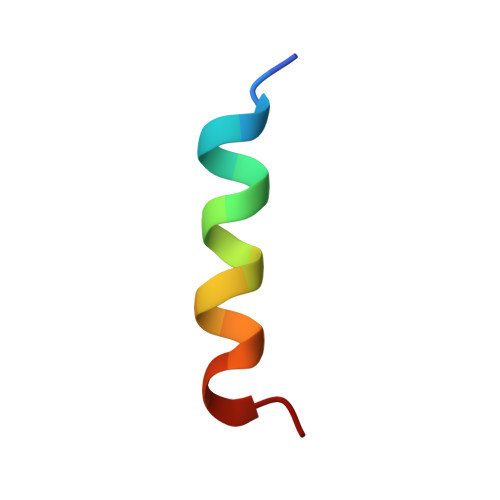Conformation of two peptides corresponding to human apolipoprotein C-I residues 7-24 and 35-53 in the presence of sodium dodecyl sulfate by CD and NMR spectroscopy.
Rozek, A., Buchko, G.W., Cushley, R.J.(1995) Biochemistry 34: 7401-7408
- PubMed: 7779782
- Primary Citation of Related Structures:
1ALE, 1ALF - PubMed Abstract:
Peptides corresponding to the proposed lipid-binding domains of human apolipoprotein C-I, residues 7-24 (ALDKLKEFGNTLEDKARE) and 35-53 (SAKMREWFSETFQKVKEKL), were studied by CD and two-dimensional 1H NMR spectroscopy. Sodium dodecyl sulfate (SDS) was used to model the lipoprotein environment. Analysis of the CD data shows that both peptides lack well-defined structure in aqueous solution but adopt helical, ordered structures upon the addition of SDS. The helical nature of the peptides in the presence of SDS was confirmed by H alpha secondary shifts. A total of 199 (apoC-I(7-24)) and 266 (apoC-I(35-53)) distance restraints were used in distance geometry and simulated annealing calculations to generate average structures for both peptides in aqueous solutions containing SDS. The backbone (N, C alpha, C = O) RMSD from the average structure of an ensemble of 20 structures was 0.73 +/- 0.22 and 0.48 +/- 0.14 A for apoC-I(7-24) and apoC-I(35-53), respectively. In the presence of SDS, the distance geometry and simulated annealing calculations show that both peptides adopt well-defined amphipathic helices with distinct hydrophobic and hydrophilic faces. The calculated structures are discussed relative to predicted structures. Comparing our CD and NMR results for the apoC-I fragments in SDS with CD results of others obtained in the presence of dimyristoylphosphatidylcholine indicates that SDS may be a better model of the lipoprotein environment.
Organizational Affiliation:
Department of Chemistry, Simon Fraser University, Burnaby, British Columbia, Canada.


















